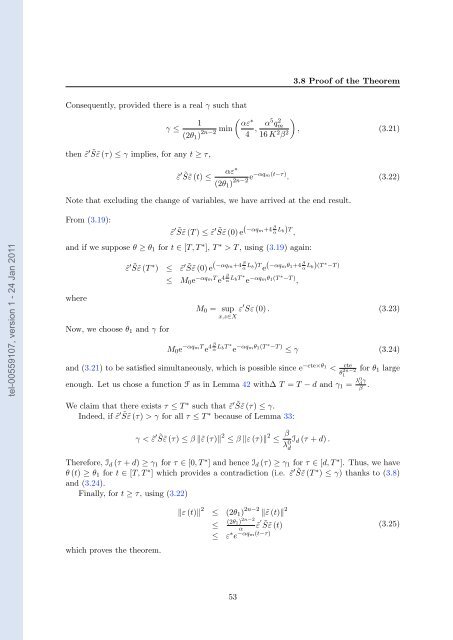Adaptative high-gain extended Kalman filter and applications
Adaptative high-gain extended Kalman filter and applications
Adaptative high-gain extended Kalman filter and applications
Create successful ePaper yourself
Turn your PDF publications into a flip-book with our unique Google optimized e-Paper software.
tel-00559107, version 1 - 24 Jan 2011<br />
3.8 Proof of the Theorem<br />
Consequently, provided there is a real γ such that<br />
�<br />
1 αε∗ γ ≤ 2n−2 min<br />
(2θ1) 4 , α5q2 m<br />
16 K2β 2<br />
�<br />
, (3.21)<br />
then ˜ε ′ ˜ S˜ε (τ) ≤ γ implies, for any t ≥ τ,<br />
˜ε ′ ˜ S˜ε (t) ≤<br />
αε ∗<br />
(2θ1) 2n−2 e−αqm(t−τ) . (3.22)<br />
Note that excluding the change of variables, we have arrived at the end result.<br />
From (3.19):<br />
˜ε ′ ˜ S˜ε (T ) ≤ ˜ε ′ ˜ S˜ε (0) e (−αqm+4 β<br />
α Lb)T ,<br />
<strong>and</strong> if we suppose θ ≥ θ1 for t ∈ [T, T ∗ ], T ∗ >T, using (3.19) a<strong>gain</strong>:<br />
where<br />
Now, we choose θ1 <strong>and</strong> γ for<br />
˜ε ′ ˜ S˜ε (T ∗ ) ≤ ˜ε ′ ˜ S˜ε (0) e (−αqm+4 β<br />
α Lb)T e (−αqmθ1+4 β<br />
α Lb)(T ∗ −T )<br />
≤ M0e −αqmT e<br />
M0e −αqmT e<br />
β<br />
4 LbT ∗<br />
α e−αqmθ1(T ∗−T ) ,<br />
M0 = sup<br />
x,z∈X<br />
ε ′ Sε (0) . (3.23)<br />
β<br />
4 LbT ∗<br />
α e −αqmθ1(T ∗−T )<br />
≤ γ (3.24)<br />
<strong>and</strong> (3.21) to be satisfied simultaneously, which is possible since e−cte×θ1 cte <<br />
θ 2n−2<br />
1<br />
enough. Let us chose a function F as in Lemma 42 with∆ T = T − d <strong>and</strong> γ1 = λ0 dγ β .<br />
We claim that there exists τ ≤ T ∗ such that ˜ε ′ ˜ S˜ε (τ) ≤ γ.<br />
Indeed, if ˜ε ′ ˜ S˜ε (τ) > γ for all τ ≤ T ∗ because of Lemma 33:<br />
γ < ˜ε ′ S˜ε ˜ 2 2 β<br />
(τ) ≤ β �˜ε (τ)� ≤ β �ε (τ)� ≤<br />
λ0 Id (τ + d) .<br />
d<br />
for θ1 large<br />
Therefore, Id (τ + d) ≥ γ1 for τ ∈ [0,T ∗ ] <strong>and</strong> hence Id (τ) ≥ γ1 for τ ∈ [d, T ∗ ]. Thus, we have<br />
θ (t) ≥ θ1 for t ∈ [T, T ∗ ] which provides a contradiction (i.e. ˜ε ′ ˜ S˜ε (T ∗ ) ≤ γ) thanks to (3.8)<br />
<strong>and</strong> (3.24).<br />
Finally, for t ≥ τ, using (3.22)<br />
which proves the theorem.<br />
�ε (t)� 2 ≤ (2θ1) 2n−2 �˜ε (t)� 2<br />
2n−2<br />
(2θ1)<br />
≤ α<br />
≤ ε∗e−αqm(t−τ) 53<br />
˜ε ′ ˜ S˜ε (t)<br />
(3.25)

















